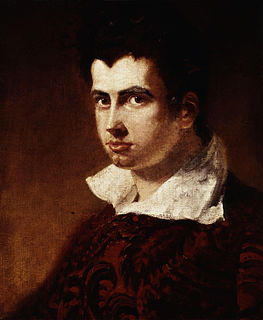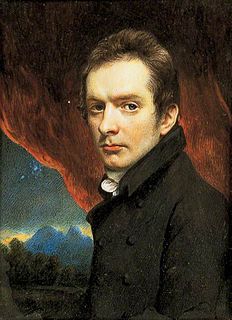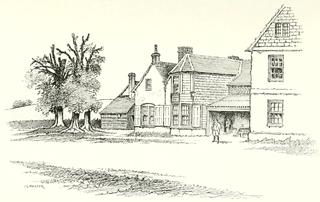
Robert Southey was an English poet of the Romantic school, and Poet laureate from 1813 until his death. Like the other Lake Poets, William Wordsworth and Samuel Taylor Coleridge, Southey had begun as a radical, but became steadily more conservative, as he acquired respect for Britain and its institutions. Other romantics, notably Byron, accused him of siding with the establishment for money and status. He is principally remembered as author of the poem After Blenheim and the original version of Goldilocks and the Three Bears.

William Hazlitt was an English essayist, drama and literary critic, painter, social commentator, and philosopher. He is now considered one of the greatest critics and essayists in the history of the English language, placed in the company of Samuel Johnson and George Orwell. He is also acknowledged as the finest art critic of his age. Despite his high standing among historians of literature and art, his work is currently little read and mostly out of print.

John Wilson of Elleray FRSE was a Scottish advocate, literary critic and author, the writer most frequently identified with the pseudonym Christopher North of Blackwood's Edinburgh Magazine.

James Henry Leigh Hunt, best known as Leigh Hunt, was an English critic, essayist and poet.

Charles Lamb was an English essayist, poet, and antiquarian, best known for his Essays of Elia and for the children's book Tales from Shakespeare, co-authored with his sister, Mary Lamb (1764–1847).
Sir Andrew Jonathan Bate, CBE, FBA, FRSL, is a British academic, biographer, critic, broadcaster, novelist and scholar. He specialises in Shakespeare, Romanticism and Ecocriticism. He is Foundation Professor of Environmental Humanities in a joint appointment of the College of Liberal Arts, the School of Sustainability and the Global Futures Laboratory at Arizona State University, as well as a Senior Research Fellow at Worcester College in the University of Oxford, where he holds the title of Professor of English Literature. From 2017 to 2019 he was Gresham Professor of Rhetoric in the City of London. Until September 2019 he was Provost of Worcester College, Oxford. He was knighted in 2015 for services to literary scholarship and higher education.
The Morning Chronicle was a newspaper founded in 1769 in London and published under various owners until 1862, when its publication was suspended, with two subsequent attempts at continued publication. From 28 June 1769 to March 1789 it was published under the name The Morning Chronicle, and London Advertiser. From 1789 to its final publication in 1865, it was published under the name The Morning Chronicle. It was notable for having been the first steady employer of essayist William Hazlitt as a political reporter, and the first steady employer of Charles Dickens as a journalist; the first newspaper to employ a salaried woman journalist Eliza Lynn Linton; for publishing the articles by Henry Mayhew that were collected and published in book format in 1851 as London Labour and the London Poor; and for publishing other major writers, such as John Stuart Mill.

Blackwood's Magazine was a British magazine and miscellany printed between 1817 and 1980. It was founded by the publisher William Blackwood and was originally called the Edinburgh Monthly Magazine. The first number appeared in April 1817 under the editorship of Thomas Pringle and James Cleghorn. The journal was unsuccessful and Blackwood fired Pringle and Cleghorn and relaunched the journal as Blackwood's Edinburgh Magazine under his own editorship. The journal eventually adopted the shorter name and from the relaunch often referred to itself as Maga. The title page bore the image of George Buchanan, a 16th-century Scottish historian, religious and political thinker.

Charles Lloyd II, poet, was a friend of Charles Lamb, Samuel Taylor Coleridge, Robert Southey, William Wordsworth, Dorothy Wordsworth and Thomas de Quincey. His best-known poem is "Desultory Thoughts in London".
The New Monthly Magazine was a British monthly magazine published from 1814 to 1884. It was founded by Henry Colburn and published by him through to 1845.

Charles Whibley (1859–1930) was an English literary journalist and author. Whibley's style was described by Matthew as "often acerbic high Tory commentary". In literature and the arts, his views were progressive. He supported James Abbott McNeill Whistler. He also recommended T. S. Eliot to Geoffrey Faber, which resulted in Eliot's being appointed as an editor at Faber and Gwyer. Eliot's essay Charles Whibley (1931) was contained within his Selected Essays, 1917-1932. Whibley died on 4 March 1930 at Hyères, France, and his body was buried at Great Brickhill, Buckinghamshire.

William Mudford was a British writer, essayist, translator of literary works and journalist. He also wrote critical and philosophical essays and reviews. His 1829 novel The Five Nights of St. Albans: A Romance of the Sixteenth Century received a good review from John Gibson Lockhart, an achievement which was considered a rare distinction. Mudford also published short fictional stories which were featured in periodicals such as Blackwood's Edinburgh Magazine, Fraser's Magazine, and Bentley's Miscellany. His short story "The Iron Shroud", about an iron torture chamber which shrinks through mechanical action and eventually crushes the victim inside, was first published in August 1830 by Blackwood's Edinburgh Magazine, and later republished separately in 1839 and 1840 with the subtitle "Italian Revenge". Edgar Allan Poe is considered to have been influenced by "The Iron Shroud" when he wrote "The Pit and the Pendulum" having got his idea for the shrinking chamber from Mudford's story. Mudford was born in London, where his father made a living as a shopkeeper in Piccadilly. He was influenced by John Milton, Joseph Addison, Samuel Johnson, William Cowper, William Collins, Mark Akenside, Thomas Gray, and Oliver Goldsmith.

William Hazlitt was a Unitarian minister and author, and the father of the Romantic essayist and social commentator of the same name. He was an important figure in eighteenth-century English and American Unitarianism, and had a major influence on his son's work.

John Hazlitt was an English artist who specialised in miniature portrait painting. He was the eldest brother of William Hazlitt – a major essayist of the English Romantic period, as well as an artist and radical social commentator – and had a significant influence on his career.

The Spirit of the Age is a collection of character sketches by the early 19th century English essayist, literary critic, and social commentator William Hazlitt, portraying 25 men, mostly British, whom he believed to represent significant trends in the thought, literature, and politics of his time. The subjects include thinkers, social reformers, politicians, poets, essayists, and novelists, many of whom Hazlitt was personally acquainted with or had encountered. Originally appearing in English periodicals, mostly The New Monthly Magazine in 1824, the essays were collected with several others written for the purpose and published in book form in 1825.
John Cavanagh was an Irish sportsman, regarded as the greatest fives player in Regency London.
The Round Table is a collection of essays by William Hazlitt and Leigh Hunt published in 1817. Hazlitt contributed 40 essays, while Hunt submitted 12.

Political Essays, with Sketches of Public Characters is a collection of essays by William Hazlitt, an English political journalist and cultural critic. Published in 1819, two days before the Peterloo Massacre, the work spans the final years of the Napoleonic Wars and the social and economic strife that followed. Included are attacks on monarchy, defences of Napoleon, and critical essays on Samuel Taylor Coleridge, Robert Southey, and Edmund Burke. The collection compiles Hazlitt's political writings, drawn largely from his newspaper articles.

Winterslow Hut was a late 17th-century coaching inn on the London to Exeter stagecoach route at Winterslow, Wiltshire, England. Its isolated location on Salisbury Plain between Salisbury and Andover, with a spring close by, made it a useful resting place for drovers, and later for stage and mail coaches.
Sarah Stoddart Hazlitt (1774–1843) was an English journalist and walker, and wife of the essayist William Hazlitt.













